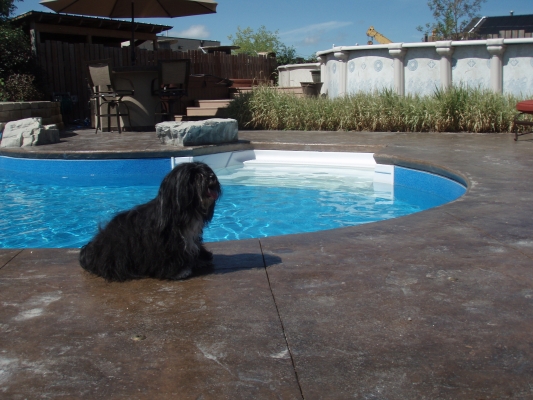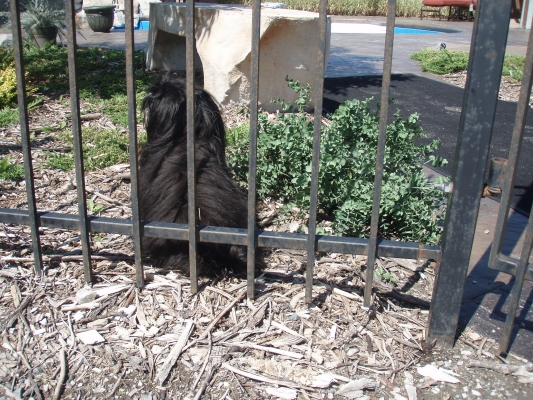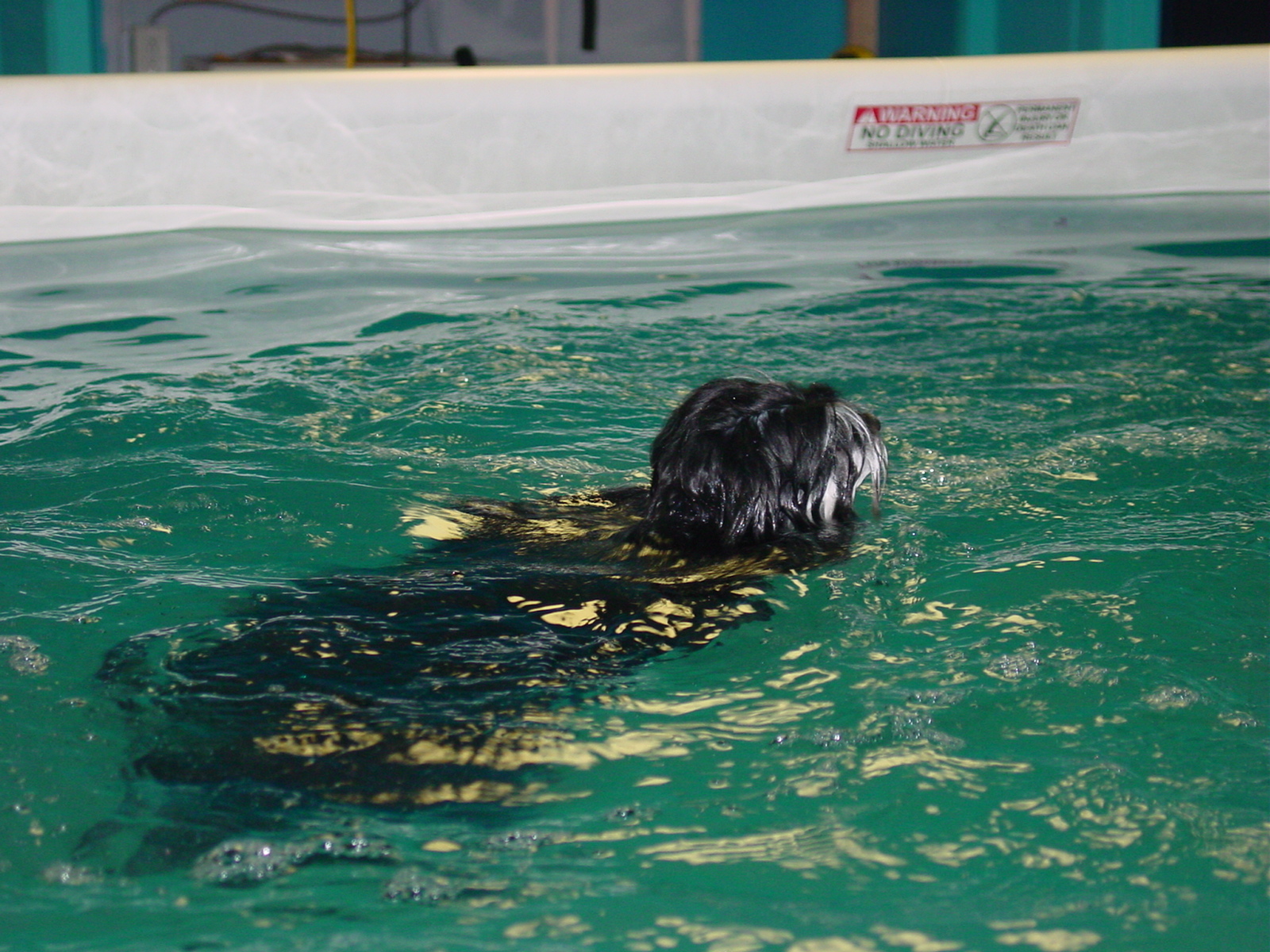Pool safety
 A backyard pool conjures images of warm days filled with carefree fun; however, the inviting water is also a potential hazard which can spell disaster to an animal lacking in pool savvy. Tragically, each year, hundreds of pets die because of pool accidents. A few basic safety precautions could prevent many of these accidents.
A backyard pool conjures images of warm days filled with carefree fun; however, the inviting water is also a potential hazard which can spell disaster to an animal lacking in pool savvy. Tragically, each year, hundreds of pets die because of pool accidents. A few basic safety precautions could prevent many of these accidents.
Careful supervision: Do not allow pets in the pool area without supervision. Even a few moments, while you run into the house to answer the phone, take a bathroom break or grab a snack, is time enough for an accident to happen. If you must leave the pool area for any reason, take your dog with you.
 Fence: Curious dogs may easily slip through gates inadvertently left open or improperly latched. A see-through pool fence with a self-closing/self-locking gate may be an option. When choosing a fence, keep in mind that dogs can wriggle through surprisingly small spaces. Gaps under the fence, around the gate and between bars are all potential problem areas. Four inches between bars (as pictured here) may seem closely spaced, but in reality, this may not be enough to keep out a small or slender dog or a young puppy.
Fence: Curious dogs may easily slip through gates inadvertently left open or improperly latched. A see-through pool fence with a self-closing/self-locking gate may be an option. When choosing a fence, keep in mind that dogs can wriggle through surprisingly small spaces. Gaps under the fence, around the gate and between bars are all potential problem areas. Four inches between bars (as pictured here) may seem closely spaced, but in reality, this may not be enough to keep out a small or slender dog or a young puppy.
Pool cover: Designed to maintain heat or prevent debris accumulation, a solar cover or pool blanket does not support weight or keep animals out. The apparently solid surface is very deceptive and may provide a false sense of security; it can give out and allow a dog to fall in to the pool. Even more frightening, the blanket may hide a struggling pet from view, the weight push him under the water and the clingy material may seriously hamper any efforts for him to find a way out. A solar cover or pool blanket is not the same as a safety cover. Pool Safety covers must meet rigid specifications to recieve a designation as a safety cover; check and know what you are buying.
Pool alarm: Consider purchasing a floating pool alarm. A disturbance in the surface of the pool will set off the alarm, alerting you to potential accidents. Note: While a helpful safety precaution, a pool alarm is of little help if no one is around to hear it.
Familiarity: Get your dog familiar with the pool and water at a young age. Many Havanese love the water and swim naturally but some may need teaching.
Exit training: Knowing how to exit a pool unaided is very different from swimming ability. A dog that falls into a pool typically paddles to the side then frantically scrabbles at the edge in an attempt to get out. Without assistance, panic and exhaustion may lead to drowning. Teaching your Havanese how to exit the pool is an important safety lesson. Even if your Havanese does not like to swim and is unlikely to enter the pool on his own, accidents do happen; one day, he may inadvertently fall in.
Exit training
Exit training does not train the dog to swim, but rather trains the dog to stay calm, orient to the pool exit and get out safely. As with any other training, start slowly and work up gradually in small steps to your final goal. Back-chaining, where the end point is taught first followed by the steps leading up to it, is a confidence-building training method which builds on steps the dog has already learned. Keep things positive and encouraging, and praise often. Note: If your dog is elderly or has any physical or health concerns, be sure to consult your veterinarian first. If starting with a puppy, wait until the puppy is big enough and strong enough to swim and to hop off a step on his own.
1) The first part of the training begins outside of the pool. Mark your exit point and teach your dog to orient to this spot. It is difficult to orient to something which is not visible. A swimming dog, until he is quite close, does not see the pool steps as they are underwater. Teach him where they are before he goes in. A visible marker, whether a waving flag, striped post or fluorescent/reflective strip may provide a landmark leading to the safe exit point. Note: If you do use an exit marker, it is important that this always be there; your dog may lose his orientation point if the marker is moved or removed. A marker can be as simple as reflective tape around a handrail or a prominent landscape feature.


Photo2: from a swimming dog's water-level view, underwater steps are much less visible
2) Time to get wet. This means you too! Never throw or push your dog into the pool. Frightening an animal is counterproductive to training. Pick up your dog and, holding him securely; enter the pool slowly, a step at a time. It is important that you do this at the steps and not using a pool ladder. Ideally, enter the pool via the exit point you are teaching. Turn towards the steps so that you are both facing the exit. Genlty lower your dog into the pool so that he gets wet. As he feels the water on his feet and belly, he may begin to paddle his front paws. He may also show some signs of insecurity. Speak softly in a calm voice; be positive and encouraging.
3) Stand your dog in the middle of the top step so that he is facing the exit and hold him there gently but firmly for just a few seconds. Tell him this is the exit; orient him to the marker if you are using one, and let him go. He will likely hop up and out of the pool on his own. You may, if you wish, place a treat by the marker or just beyond the top step, so that he gets a reward for orienting to the correct place and exiting the pool. Your dog may run away at this stage. That's Ok. After a couple of minutes, get your dog and repeat the exercise. Repeat several times during the day till your dog consistently hops out when placed on the step. Most dogs are ready for the next stage after just a few practice sessions, though a few need a day or longer.
4) Carry your dog into the pool via the steps and go into the water so that you are a few feet away when you turn and face the steps. Lower your dog gently into the water till he must paddle to stay afloat. Orient him to the exit, encourage him to paddle to the step, and get out of the pool. If he paddles frantically and appears distressed, keep your hand on his collar or under his belly (for guidance and reassurance rather than support). Bring him closer to the step so he only has a short way to paddle to get out. You are working towards calm confidence. Speak in a positive encouraging voice; Repeat this step several times during the day.
5) Gradually work your way back 3-4-5-6 feet out from the steps so your dog has to swim further to get to the steps. As your dog gets proficient at swimming to the exit, start making it more difficult. Move so you are no longer directly in front of the steps. Change directions, first from the side and then facing away from the step, so that your dog learns to orient himself to the exit from any direction. If he paddles away from you in the wrong direction, turn him immediately back to facing the exit. Remember to praise, praise, praise. After your session is done, loving attention and a play session are great rewards for a job well done.
6) Stay in the shallow end until your dog becomes relaxed and confident, then gradually move to deeper water. As proficiency increases, you will want to work these exercises from all different areas of the pool. No matter where he is in the pool, you want your dog to be able to orient easily to the exit and make his way there. During the training stages, it is important that you always stay in the pool with your pet for safety and control.
7) Once your dog is adept at swimming directly to the exit, it is time for a final test. You will be outside of the pool for this test. Kneel on the pool deck and gently lift and place your dog into the water at the edge (simulates point of entry if your dog accidentally fell in). Walk along the edge of the pool and encourage your dog to swim to the steps and exit the pool.
Once your dog is adept at swimming directly to the exit, it is time for a final test. You will be outside of the pool for this test. Kneel on the pool deck and gently lift and place your dog into the water at the edge (simulates point of entry if your dog accidentally fell in). Walk along the edge of the pool and encourage your dog to swim to the steps and exit the pool.
8) If your pool has multiple safe pet exits, train your dog on the primary exit first, you can the train the second exit by alternating in practice. Keep things simple. Specially designed pet ladders or escape ramps with slip-resistant surfaces are available. Escape ramps may be especially useful for older pets that have trouble negotiating steps, or for smaller pets that cannot easily hop off a pool step. Pet safety steps and escape ladders extend above the surface of the pool providing a visible orientation marker.
9) Plan regular reminder sessions. Even a dog that has been in and out of the pool many times may forget where the safe exit is, especially if it has been several months since the pool has been open. Take your dog into the pool regularly during pool season to practice. The more often you practice, the likelier your dog is to remember the drill when he accidentally falls in or panics.
TIPS
- Exit training does involve swimming which can be physically demanding and very tiring. Allow short rest breaks between sessions. Longer breaks and shorter sessions may be nevessary to accomodate age, physical condition and abilities.
- Always provide fresh drinking water in the pool area. Do not let your dog drink pool water; the chlorine will make him sick.
- After your swimming/training sessions are done for the day, shampoo your dog or at least rinse him off with fresh water. Chlorine and other pool chemicals can be harsh and drying to the coat.
- If any pet has a pool injury or near-drowning experience, take him immediately to your veterinarian for a check up and professional advice.
During your exit training, you may discover that your pet loves to swim. Swimming and water play can be a wonderful way to exercise your pet, play with him and enjoy warm weather days together. These few common sense precautions will help you keep your pet safe so you can both enjoy the pool for many years to come.
Thank you to Chris Anderson for assistance in research and editing this article